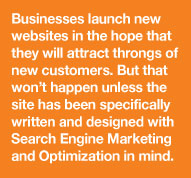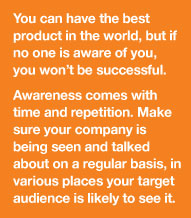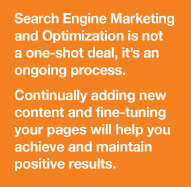Search Engine Marketing (SEM) and Search Engine Optimization (SEO): Don’t Leave Home Without Them
 These two concepts have become unbelievably important for companies today. This article will explain the important terms and acronyms you’ve been hearing about and help you get started in the world of search.
These two concepts have become unbelievably important for companies today. This article will explain the important terms and acronyms you’ve been hearing about and help you get started in the world of search.
Most businesses have a web site built in order to gain more exposure for their company. They hope their great new site will bring in throngs of new visitors. They are very disappointed when that doesn’t happen. It won’t happen unless your site has been specifically written and designed with Search Engine Marketing in mind. Beware of web designers who are not familiar with the in’s and out’s of Search Engine Marketing and Search Engine Optimization.
Search Engine Marketing (SEM)
SEM is the practice of setting up and running a successful online presence while gaining maximum search engine visibility. Your visibility on the web is made up of two different factors: organic search engine rankings and paid listing and advertising. Organic rankings are what you get for free. When you publish a web site a search engine robot will eventually find it (either by itself or as a result of your paid submission). The robot will “read” your site, analyze its content and add it to the index. Now your site will be found when people use that search engine and query it for some words contained in your pages. Your place on their search results page is your organic search engine rank. The closer your rank is to number one the more traffic you’ll get.
Search Engine Optimization (SEO)
SEO techniques can be used to raise your ranking in the search engines’ organic results. SEO is an ongoing process of reviewing your content, keywords, design and web site coding to increase the page’s relevance and raise it to the top of search engine results pages. Each page of your site is ranked separately, so you can (and should) optimize each page for different relevant search terms. If your company sells furniture you should have separate pages devoted to living rooms, dinning rooms, bedrooms and so forth, and each of those pages should be optimized for their own specific search terms, not for furniture in general.
In your quest for site traffic beware of Black Hat SEM/SEO. Techniques such as stuffing your page with keywords, or signing up for hundreds of incoming links from an online service will only backfire. These techniques are always quickly identified by the major search engines who will then penalize your site with poor rankings, or blacklist your site entirely from their results. It’s just not worth any short term success you might achieve.
Web Analytics is another strategy that is used for both SEM and SEO. It involves collecting, analyzing and using information about your site’s visitors to increase traffic and/or sales. By analyzing their surfing behavior, the ways they have found your site, the efficiency of your links and advertising, your conversion rates and other eCommerce information you can alter aspects of your site to make it much more effective. Tracking this data over time and putting your resources behind what’s working and changing what isn’t can produce tremendous results. Many hosting providers offer these traffic analyzing packages as an option for your hosting account. There are also numerous third party providers with robust traffic tracking products available. Any serious web effort must include web analytics to succeed.
Online Advertising – The World of Pay-Per-Click
Advertising your product or service online is a great way to get your target audience to notice you. The web allows you to be very specific about where your ads will appear and who is likely to see and hopefully respond to them. Once you’ve optimized your web site according to certain keywords and phrases your customers are likely to use to search for you, you can now target advertising to those customers using those same keywords. Many search engines offer advanced pay-for-performance programs such as “sponsored results” that you often see at the top of your results page, and sponsored links or ads next to the organic results (pay-per-click ads). Google AdWords is the best known name in the game, although there are many others out there.
In these Pay-for-Performance advertising programs listings/ads are guaranteed to appear in response to particular search terms next to the search results, or on certain web sites in a Placement Targeting campaign. Where and when they appear depends on how much you are willing to pay. In a Pay-Per-Click (PPC) campaign you specify the maximum amount you’re willing to pay for each click and you only pay when someone actually clicks on your ad. Pay-Per-Click listings are usually offered by search engines in an auction format where keywords and phrases are associated with a cost-per-click (CPC) fee. The higher you bid for a keyword, the higher your position on the webpage will be. There is also a Cost-Per-Impression (CPM) model used by many content sites where you pay per 1,000 viewings regardless of whether or not visitors click on your ad. Both of these models let you set a maximum budget per day, so you won’t get a surprisingly large bill.
Smart web marketers try to use both organic optimization and paid strategies, in the correct amount, to get maximum results. What can you expect from each strategy?
For raising your rank in organic listings:
• Increase the amount of traffic to your site.
• Increase the quality of the traffic by gaining high rankings through SEO for those keywords your prospects are using.
For paid listings:
• Monitor your keywords to gauge the amount of traffic they are bringing. Switching off advertising for under-performers will help you spend wisely.
• Find the right keywords that have been proven productive in your ads and use them in your site’s content to help improve organic ranking.
• Increase brand awareness by being seen on relevant, trusted content sites.
 Local Search
Local Search
A major problem for smaller companies with limited SEM budgets is that big corporations usually dominate the search results for common keywords. If your product or service is used locally, applying local search techniques is a great way for the smaller guy to stand out. Examples of local search terms could be “Boston hotels”, “italian restaurant 02346”, they are much more specific than a general search. You can use this information when optimizing your site’s pages by including local search terms in your text, page titles and page descriptions.
There are also a growing number of local search services online. They’re all a little different, but in general you select a business category and a geographic area and the site will give you a map and list of relevant links for your category. At the top you will most likely find paid ads that are targeted to your search criteria. Sites like local.com even offer banner ads and user reviews. MerchantCircle offers tools for advertisers including landing pages, coupons, blogs and more to improve the effectiveness of your local effort. CitySearch.com provides local information to major sites such as MSN, ask.com, Expedia.com and others. You’ll want to make sure your business is listed there and that all the information is current.
Small businesses will want to take advantage of any free listings these sites offer, then weigh the benefits of their paid options on a site by site basis.
Some SEM terms you may want to learn are:
Keyword Prominence: The measure of keyword importance that indicates how close a keyword is to the beginning of the analyzed page area. Prominence is calculated separately for each important page area, e.g. page title, body, etc. As an example for page titles let’s look at two.
Cooks Expo – Kitchen appliances at affordable prices.
Kitchen appliances at affordable prices – CooksExpo.com
If your keywords are “kitchen appliances” the second title will have 100% prominence because those are the first words that appear in the title.
Keyword Density or Weight: A measure of the percentage of keywords to the general number of words on a page. You want high keyword density while maintaining natural readability for your visitors. You will also want to avoid keyword stuffing – artificially inflating the amount of keywords on a page in order to fool a search engine into giving you a high rank. This is considered spam by the search engines.
Keyword Frequency: The number of times a keyword is used in the area of the web page being analyzed. Unlike density, this does not depend on the number of words in that area, it is an absolute index. If you repeat your keyword 5 times your frequency will be 5.
Keyword Proximity: Some engines, including Google, measure how close keywords that make up your key phrase are to each other. In other words, if you have a key phrase of “brown spotted horses” Google will give a higher rank to sites that use those words as one phrase instead of separately, as in “Mr. Brown was recently spotted at an equestrian event where various local breeders were showing their horses.” That page would rank much lower for keyword proximity.
 Link Popularity: The number of links from other high-ranked pages to your site. This has become more and more important to search engine rankings as a way of measuring the quality and relevance of your content. Just like with keyword spamming, getting hundreds of irrelevant links from some companies promising you high rankings is risky business with the search engines. Quality is more important than quantity here.
Link Popularity: The number of links from other high-ranked pages to your site. This has become more and more important to search engine rankings as a way of measuring the quality and relevance of your content. Just like with keyword spamming, getting hundreds of irrelevant links from some companies promising you high rankings is risky business with the search engines. Quality is more important than quantity here.
All of this optimization must be done while still assuring that the content sounds natural to your human visitors.
It’s great to know some of the lingo and techniques involved in Search Engine Marketing and Optimization but, this is just the tip of the iceberg. You may want to hire a professional for the job. Either way SEM is not a one shot deal, it’s an ongoing process. Continually changing and fine tuning your pages will help you achieve maintain positive results.






